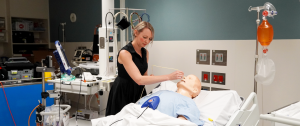Many patients arrive at hospital with malnutrition. Dietitians at Central Adelaide Local Health Network (CALHN) help them leave in better shape.
Gail (pictured) is Senior Dietitian in Allied Health at CALHN, and is based at the Royal Adelaide Hospital.
“Malnutrition is both a cause and a consequence of illness, and it affects every area of our hospitals,” said Gail.
“Addressing malnutrition improves patient health, lowers length of stay in hospital, and reduces the need for intensive nursing and pharmaceutical support.”
Working with her colleagues, Gail set up CALHN’s Malnutrition Strategy as a comprehensive framework to target malnutrition in consumers across the network’s health services.
“Fundamentally, our strategy is all about improving patient safety and quality of care,” Gail said.
“Through creating new training opportunities for nurses and allied health staff, we focus on identifying malnutrition when it occurs, and then putting steps in place to help patients improve their nutritional status.”
Not eating enough
While there are many subtypes of malnutrition, Gail and her colleagues focus particularly on protein and energy undernutrition.
This type of malnutrition typically results from not eating enough food each day. It is often seen in hospitals when patients experience nausea or vomiting after chemotherapy, or if they have problems with chewing or swallowing after a stroke. Malnutrition can also stem from poor absorption of nutrients due to illness, and other factors.
“Our studies show around 50% of our patients coming in to CALHN hospitals are malnourished,” Gail said.
“At CALHN we’ve set up systems so we can quickly identify patients who are malnourished, and start putting things in place to get them back on track.”
For inpatients, CALHN addresses malnutrition with special menus offering nutrient-dense food, as well as through oral nutrition support products, and enteral (via the gut) and parenteral (intravenous) nutrition if required.
When patients transition to going home, they are provided with information and education to continue good nutrition, including a focus on the types of food to buy and consume, meal delivery services and support from dietitians.
Training staff to spot malnutrition
CALHN’s Malnutrition Strategy includes a comprehensive training package for nurses so they have better understanding of malnutrition and are able to complete malnutrition screening in patients.
A group of Nutrition Nurse Champions ensures the malnutrition strategy is embedded into daily operations.
CALHN dietitians also undertake ongoing competency-based training in the assessment and management of malnutrition.
“Thanks to our strategy, we’ve seen a positive impact on patient nutrition,” Gail said.
“This includes lowered incidence and severity of malnutrition, better awareness among staff of the importance of good nutrition for recovery, and patients feeling empowered to improve their health and wellbeing through nutrition.”
The CALHN Malnutrition strategy has educated 865 staff across sites network wide, with an additional 180 staff currently enrolled. Twenty three Nutrition Nurse Champions have been appointed network-wide.



